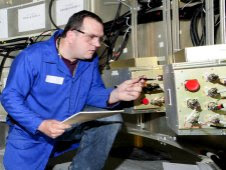
"Having more than one string on a fiddle" is an old phase used to describe someone or something with multiple talents or uses. This expression could be used to describe NASA's avionics string testing -- a developmental testing process that allows engineers to find and fix any bugs in a system by inputting commands and scrutinizing the electronics system’s responses.
NASA and ATK Aerospace Systems of Magna, Utah, prime contractor for the Ares I first stage avionics system, currently are conducting a series of string tests at ATK's test facility in Clearfield, Utah.
So exactly what is an avionics system and how is NASA using string testing to help design the next generation of solid-rocket-motor-based launch systems?
The avionics system is the "brains" for a launch vehicle, consisting of the electronics system, equipment and associated sensors responsible for controlling key guidance, launch, navigation and recovery hardware. The first stage avionics works with the upper stage flight computers and guidance systems to control the vehicle during first stage ascent and executes recovery of the first stage after staging.
During testing, control boxes of the first stage avionics system are wired together in a line -- the so-called string – with multiple strings making up the entire avionics system. The strings are connected to a ground computer which simulates the upper stage flight computer by issuing commands to the appropriate control box, requiring a particular response.

"System level or "string" testing is a widely recognized process that allows our team to locate and identify functional and performance-related problems within the hardware," said Kendall Junen, avionics and control team lead for Ares Projects at NASA's Marshall Space Flight Center in Huntsville, Ala. "It involves taking various system requirements and testing the hardware in controlled laboratory scenarios to determine how well the system performs."
"This laboratory allows us to test like you fly. We can assemble the entire avionics system and put it through precise, flight-like scenarios," he said. "We can test the system's reaction to certain computer-generated anomalies and identify potential performance issues associated with specific hardware."
NASA and ATK Aerospace Systems of Magna, Utah, prime contractor for the Ares I first stage avionics system, currently are conducting a series of string tests at ATK's test facility in Clearfield, Utah.
So exactly what is an avionics system and how is NASA using string testing to help design the next generation of solid-rocket-motor-based launch systems?
The avionics system is the "brains" for a launch vehicle, consisting of the electronics system, equipment and associated sensors responsible for controlling key guidance, launch, navigation and recovery hardware. The first stage avionics works with the upper stage flight computers and guidance systems to control the vehicle during first stage ascent and executes recovery of the first stage after staging.
During testing, control boxes of the first stage avionics system are wired together in a line -- the so-called string – with multiple strings making up the entire avionics system. The strings are connected to a ground computer which simulates the upper stage flight computer by issuing commands to the appropriate control box, requiring a particular response.

"System level or "string" testing is a widely recognized process that allows our team to locate and identify functional and performance-related problems within the hardware," said Kendall Junen, avionics and control team lead for Ares Projects at NASA's Marshall Space Flight Center in Huntsville, Ala. "It involves taking various system requirements and testing the hardware in controlled laboratory scenarios to determine how well the system performs."
"This laboratory allows us to test like you fly. We can assemble the entire avionics system and put it through precise, flight-like scenarios," he said. "We can test the system's reaction to certain computer-generated anomalies and identify potential performance issues associated with specific hardware."
